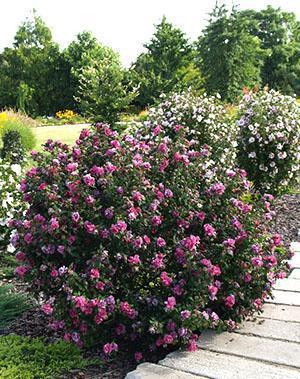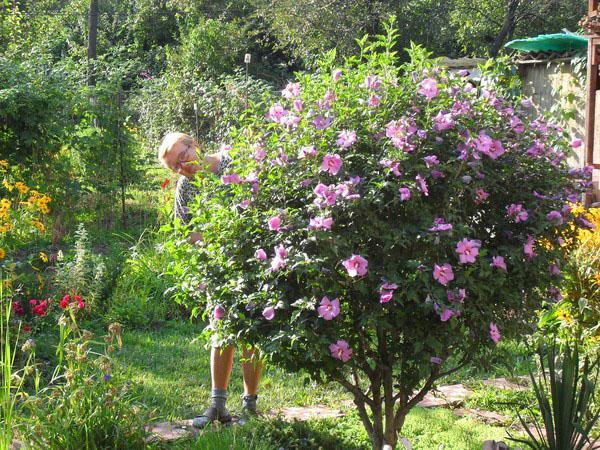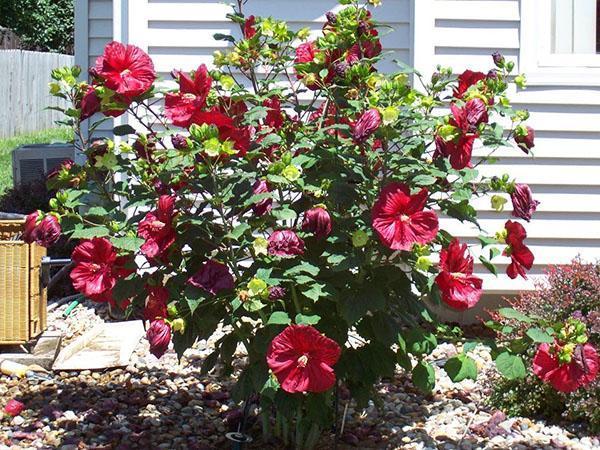Syrian hibiscus in central Russia and Ukraine
 Cultivated tropical plants are striking in their beauty. Syrian hibiscus is especially often used in street gardening. It has a relatively high frost resistance. In the southern latitudes of the country, tree-like hibiscus hibernates even without additional shelter. The plant moves to the north, risking freezing in winter. But already in Kaliningrad and in the Moscow region, Syrian hibiscus is used in landscaping.
Cultivated tropical plants are striking in their beauty. Syrian hibiscus is especially often used in street gardening. It has a relatively high frost resistance. In the southern latitudes of the country, tree-like hibiscus hibernates even without additional shelter. The plant moves to the north, risking freezing in winter. But already in Kaliningrad and in the Moscow region, Syrian hibiscus is used in landscaping.
Features of growing Syrian hibiscus in the middle lane
The biology of the plant is such that the double forms of flowers were obtained as a result of selection work. Therefore, a simple inflorescence is a sign of greater resistance to frosty wintering. Hibiscus (photo) can survive a short-term drop in temperature to -200 without shelter. Such conditions can be guaranteed only in the southern regions. Therefore, the Syrian hibiscus in the Moscow region should winter under a protective structure.

 All of this points to a different path for landscaping with tropical flowers. If you build a greenhouse made of plastic wrap over a group of plants in spring, the earth will warm up faster, and the growing season will begin earlier. Thus, it is possible to win back up to two weeks from nature and get the Syrian hibiscus, as in the photo.
All of this points to a different path for landscaping with tropical flowers. If you build a greenhouse made of plastic wrap over a group of plants in spring, the earth will warm up faster, and the growing season will begin earlier. Thus, it is possible to win back up to two weeks from nature and get the Syrian hibiscus, as in the photo.
More often in the middle lane and northern regions, tropical plants are grown in containers. On the territory they are placed in single or group spots.
Containers can be buried in the ground or installed on the surface. Once the buds have formed, the containers must not be moved or rotated.
Winter storage hibiscus Syrian is conducted at low temperatures of 5-15 degrees. By creating conditions for development, cutting and feeding the plant, it can be kept in a tub for up to 20 years. In such conditions, it is possible to grow the most beautiful double flower varieties in Siberia.
Varietal variety of Syrian hibiscus photo
 The indescribable beauty of flowers is best seen. Plants in the middle lane grow up to one and a half meters. By trimming, you can give the plant the desired shape.
The indescribable beauty of flowers is best seen. Plants in the middle lane grow up to one and a half meters. By trimming, you can give the plant the desired shape.
Syrian hibiscus Ardens (purple). The bush is compact, always double, with inflorescences ranging from pink to dark lilac flowers. Grows well in Ukraine with minimal cover.
Syrian hibiscus Rosentus Plantus is a deciduous shrub. Large toothed curly leaves. Shelter is required in winter. It is also cultivated as a houseplant.
Hibiscus Syrian Blue Chiffon is a continuation of the "chiffon" series. This variety is distinguished by a pure blue color, turning into blue without lilac impurities. There are few such flowers in nature. Blue Chiffon is the novelty of the season.
The variety of colors and shades of hibiscus makes it a desirable decoration for any garden.
Syrian hibiscus - planting and care
 For growing hibiscus outdoors in the middle lane, you need to create favorable conditions for the development of the plant. They need:
For growing hibiscus outdoors in the middle lane, you need to create favorable conditions for the development of the plant. They need:
- light, nutritious, drained soil;
- regular watering soft warm water as needed;
- balanced fertilizing with mineral and organic fertilizers;
- the place is sunny, but sheltered from the wind and direct rays.
And a beautiful tree also needs love. The more often people visit him and talk to him, the more beautiful it becomes. But you need to approach him with a bow in order to loosen the ground. In the morning or evening, sprinkle the leaves with a warm shower in the cool. At the same time, see if aphids have come. In three days, instead of beautiful leaves, she will leave crumpled fists.
 After pruning old branches, you can put them in a bucket of water and get excellent planting material in a month. Plants that have overwintered in pots in a warm room can be planted. Or you can create an open-air nursery. Only in autumn will young plants require particularly careful insulation. The onset of flowering depends on where the cuttings are grown. After a warm winter, they will bloom the next year. After the nursery - 3 years will grow up.
After pruning old branches, you can put them in a bucket of water and get excellent planting material in a month. Plants that have overwintered in pots in a warm room can be planted. Or you can create an open-air nursery. Only in autumn will young plants require particularly careful insulation. The onset of flowering depends on where the cuttings are grown. After a warm winter, they will bloom the next year. After the nursery - 3 years will grow up.
An interesting way is to grow Syrian hibiscus from seeds. Such reproduction can make you happy with the receipt of a new flower, which is different from those sitting nearby and participating in pollination. Terry is not transmitted by seeds, only coloring. Therefore, this method is more often used by breeders. Moreover, a young seedling starts flowering in 4-5 years.
For seed propagation, stratified seeds are soaked in a stimulator and germinated before pecking in a warm place.
In the prepared substrate, seeds are sown in separate cups. You can sow in a bowl, but then you need to dive after the appearance of the second leaf. Babies should grow up in a warm, bright place.
 With the appearance of the sixth leaf from the seedlings, they begin to form a bush, pinching the tops. As they grow, young hibiscus are transplanted into new dishes by transshipment, fed and left to winter in a cool room. The next year, plants from seeds are arranged in a permanent place.
With the appearance of the sixth leaf from the seedlings, they begin to form a bush, pinching the tops. As they grow, young hibiscus are transplanted into new dishes by transshipment, fed and left to winter in a cool room. The next year, plants from seeds are arranged in a permanent place.